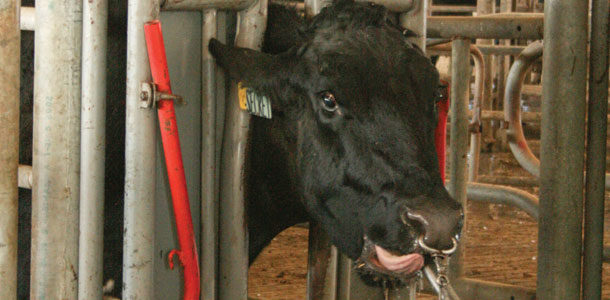Nutrition is always of paramount importance to dairy producers. But during the transition period, one particular nutrient becomes a central focus: calcium.
With calcium supplements available in the form of boluses, oral drenches, IV bottles, gels and pastes, it can be difficult for producers to choose which is best for their transition cows. Balancing cost, ease of use and results, a number of industry representatives weighed in on which options they prefer.
Boluses are the preferred calcium delivery method for Lee Jensen of Five Star Dairy in Elk Mound, Wisconsin. Although he started using the product skeptically, he found boluses reduced the incidence of milk fever and could be easily administered using a stall with a head catch for restraint. He also says the pills are longer-lasting than IV calcium, which he still uses for cows with ketosis.
Jensen did not always use boluses on his 1,100-cow dairy. Previously, every cow received a calcium drench, an administration technique he found expensive and time-consuming. Safety also became a concern when one cow was killed from inhaling the liquid.
“I think the boluses are way safer than the drenches, myself,” Jensen says.
Steve Weinzirl of Val-O-Mo Farms Inc. in Elmwood, Wisconsin, agrees. Although he uses a propylene glycol drench as a source of blood glucose for cows with ketosis, he does not like this method because cows tend to cough after administration.
Weinzirl uses boluses to provide calcium to his 500 Holsteins during the transition period. He provides one bolus at calving to 3-year-olds and an additional bolus 12 hours later to cows 4 years old and older.
Since using the boluses, Weinzirl says he rarely needs to administer calcium intravenously, which was a routine practice.
Some boluses can provide additional nutrients, making them advantageous in helping a cow during the transition period, says Michelle Lancaster of Spirited Rose Homestead Dairy Farm. Michelle and her husband, Jay, offer advice to family dairies on their website.
On their former 100-cow dairy in Ferndale, Washington, the Lancasters administered a CMPK bolus up to one week before calving to those cows that had previous incidences of milk fever. In addition to calcium, these boluses deliver the minerals magnesium, phosphorus and potassium, as well as some extra vitamins to help correct possible nutritional imbalances.
For rapid calcium delivery, Dr. Jack Register – a practicing veterinarian for 40 years and founder of Dr. Register and Associates – recommends his calcium drench formula. Whereas boluses and pastes are slowly absorbed in the rumen, liquid calcium chloride directly enters the omasum and abomasum by stimulating closure of the esophageal groove, he says. This raises blood calcium levels in 15 minutes.
“The quick absorption will also bring the vitamins and herbal antibiotic into the cow when needed,” Register says.
Unlike most boluses, the drench is effective in cows suffering from milk fever, Register says. It can also be given every four to six hours without fear of rumen acidosis.
Register recommends one 300-cc dose a day for three days following calving. For cows with a history of milk fever, an additional dose can also be administered before calving.
Mike Johnson of Jerland Farms in Barron, Wisconsin, provides a 300-cc dose of a calcium drench to his cows immediately after calving and again eight to 10 hours later. After a cow’s third calf, Johnson also administers IV calcium for extra protection against milk fever.
To ensure safe delivery, it is important for a producer to apply the gun and release the drench slowly so the cow can swallow the liquid naturally, says Register. A non-burning formula also prevents resistance from the cow. By placing the gun between the cheek and teeth, Register says accidental inhalation and possible aspiration pneumonia can be minimized.
Register also developed a calcium gel with the same formula and 15-minute response but a sweeter taste that makes administration easier. Although more expensive than the drench, Register says the gel is still cheaper than most boluses.
Aside from supplying supplemental calcium, dairy producers have found a number of other practices beneficial in helping cows and heifers through the transition period.
To help reduce stress in the summer and winter, Jensen installed a tunnel ventilation system in his 550-foot-long freestall barn for dry and fresh cows. On hot days when the humidity is below 50 percent, high-pressure fog can also help cool the facility.
Diet is another key factor. While Jensen previously fed the same diet to all of his dry cows, he now gives a separate recipe to far-off dry cows and pre-fresh dry cows. He also maintains a minimum bunk space of 24 inches.
On their website, the Lancasters recommend limiting the intake of calcium-rich alfalfa during the dry period to prevent milk fever. Preventing constipation is also crucial to ensure proper nutrient utilization, says Michelle.
Despite these efforts, producers still face a variety of challenges during the transition period.
Although he attempted to oversize his barn by 30 percent, Jensen experiences some overcrowding during occasional calving surges. If any group is populated more heavily during these instances, it will be those dry cows furthest from parturition, he says.
For Johnson, the biggest problem this year is ketosis after calving, especially for heifers. To prevent this condition, the farm is attempting to feed more hay to keep heifers thin, starting as yearlings before they are bred.
Whether space, diet or calcium supplementation, producers consider a multitude of factors when forming management strategies for their transition cows. While none follow the exact same protocol, each has developed an ever-adapting strategy that is effective on their farms and for their lives. PD
Holly Drankhan is a freelance writer and an incoming student at the Michigan State University College of Veterinary Medicine.
PHOTO: Staff photo.







